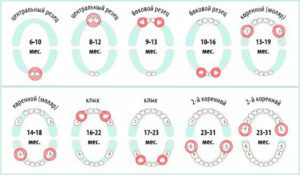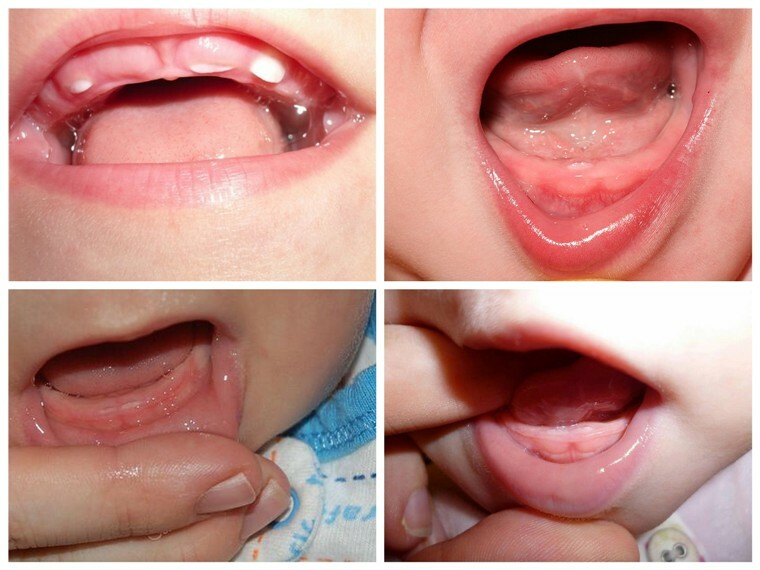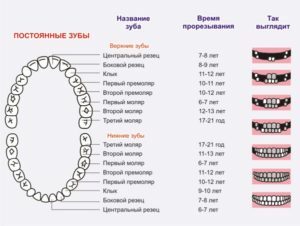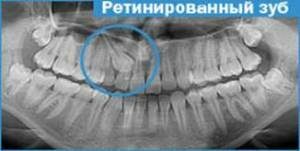 The appearance of the first tooth in crumbs is eagerly awaited by all parents.
The appearance of the first tooth in crumbs is eagerly awaited by all parents.
But this process is often associated with various troubles, because often eruption of milk teeth can cause a rise in temperature and worsening of the general condition.
Let's take a closer look at how to help the baby in this situation and when to expect teething.
Contents of
- In what order are the baby teeth pierced?
- Cutters - the first guests in a small state
- In their wake the root
- climb When fangs come out?
- Teeth dissolution formula
- The procedure and timing of permanent teeth eruption
- Possible problems
- Adentia
- Retention
- Early teething
- Teeth eruption
- Sequence violation
- Enamel hypoplasia
- How to determine that your baby has teeth?
- How and how to relieve the child's condition?
- Baby tooth care
In what order are the teeth squashed?
The rudiments of the teeth form in the womb. The newborn has 20 follicles located in the lower and upper jaw, it is from these that the milk teeth develop.
Cutters - the first guests in a small state
They are in the lower and upper jaw, 2 central and 2 lateral in each. Teething starts from the central lower incisors at the age of 5-6 months. The top leaves 1-2 months later.
Side incisors in the child, too, 4, they are located near the central ones. The upper ones erupt when the child reaches 9-11 months of age, the lower lateral incisors appear later, from 11 to 13 months.

In the photo, the cutting of the upper teeth of the toddlers
The root
follows them. Another name for these molar teeth is molars. They are divided into the first and second.
The first molars are located near the fangs in both jaws, 4. They appear in the child not earlier than 12-16 months.
The second molar molars are the latest, this process is observed after two years. They are located behind the first( small) molars.

Diary of infant teeth in children
When will the fangs come out?
Their turn comes when the kid turns 16-20 months old. Are in front of the first molars. During this period, it is necessary to try to prevent the development of colds, as fangs often cause a deterioration in the health of the baby.
This order of eruption of baby teeth in children is considered a classic. Perhaps their appearance several months earlier or later from the above dates.
This is also the norm. In medicine, even cases where newborns already had milk teeth are known.
Teeth cutting formula
To determine the number of baby teeth in a child is very simple, you need to take four of its age taken in months. The result obtained will denote their number. For example, if the child is 11 months old, then according to the formula he should have 11-4 = 7 teeth. This formula is valid up to 2 years.

The order and timing of permanent teeth eruption
The beginning of the eruption of the first permanent teeth should be anticipated sooner than the first dairy one falls out. In order for a child to have a correct bite, they break through in pairs and in a certain order:
-
 The first molars .They are also called the "sixth teeth".They erupt at once constant, are placed near the second molar molars. This happens when the child reaches 6-7 years of age.
The first molars .They are also called the "sixth teeth".They erupt at once constant, are placed near the second molar molars. This happens when the child reaches 6-7 years of age. - Central incisors of replace fallen dairy. The lower in 6-7, and the upper in 7-8 years.
- The lateral permanent incisors of grow on the dairy site. From below they appear in 7-8, and from the top in 8-9 years.
- The first premolars of replace the first molar molars. This happens not earlier than 10 years.
- The second premolars of come out on the places of fallen dairy second molars. On the upper jaw they appear in 10-12, and on the lower one - in 11-12 years.
- In place of fangs, the fangs grow the same, but already permanent teeth. Lower at the age of 9-10 years, upper - 11-12.
- The second molars are cut immediately constant near the first in 11-13 years, and the lower ones are slightly earlier than the upper ones.
- Third molars also grow at once constant, these are all known "wisdom teeth".They can appear from 17 to 25 years. Often they are generally absent.
Possible problems
The above mentioned periods of teething are the norm. But under the influence of certain factors, there may be problems associated with this process.
Adentium
It can be talked about in the absence of one or more teeth and their rudiments. The diagnosis is not earlier than 10 months of age. The cause may be heredity, problems with the endocrine system, concomitant diseases of other organs.
Signs of an adentia are:
- incorrect bite;
- violation of diction;
- absence of one or more teeth;
- large gaps between teeth;
- sunken cheeks.
If the rudiments are there, the doctor prescribes a treatment that will stimulate eruption. Sometimes, gums are cut or special braces are installed. In their absence, implants are used.
Retreatment
 In this pathology, the tooth rudiment in the gum is, but it does not erupt for two reasons:
In this pathology, the tooth rudiment in the gum is, but it does not erupt for two reasons:
- is too dense gum;
- the tooth at the outlet rests against the previously cut tooth.
It is manifested by soreness, edema, hyperemia, fever. Treated by cutting the gums or removing the retinas.
Early Teething Teeth
The appearance of the first teeth earlier than 4 months of age is considered to be early. This happens often with violations in the endocrine system, and can also talk about the presence of tumors.
Later Teething Teeth
This problem can be talked about if the teeth are missing at the age of 10 months. This leads to a lack of calcium, a genetic predisposition, a violation of enzymatic metabolism, pathology of the digestive system, rickets and other factors.
If by 1 year the child has no teeth, show the crumb to the dentist.
Sequence violation
Occurs if the teeth appear in the wrong sequence. Can lead to ingrown teeth in the gum and the formation of an incorrect bite.
Hypoplasia of enamel
Develops with inferiority of enamel. Outwardly manifested by the presence of grooves, pits, roughness on the surface of the teeth. The child complains of pain when taking cold or hot food.
Treatment consists in the elimination of harmful factors, the establishment of seals or prostheses.
How to determine if your baby has teeth?
A small child can not tell the cause of his anxiety. But during the appearance of teeth, you can see the following changes in his condition:
- increased salivation;
- edema and redness of the gums;
- weakness, crying, anxiety;
- refusal of food;
- the child gnaws everything that comes by the hand;
- there may be a slight increase in temperature.
The photo shows how the gums look when teeth are teething in babies:

How and how to relieve the child's condition?
It's impossible to completely avoid the eruption symptoms, but you can alleviate the condition of the baby:
- use the cooled teethers, they will relieve edema and relieve soreness;
- it is also possible for to massage the gums of the with a finger, after having washed hands well;
- to reduce pain, use gels with anesthetic effect ;
- provide sufficient intake of products that contain a lot of calcium ;
- in time wipe the saliva to avoid irritation of the delicate skin of the baby.
Baby tooth care
 To begin hygiene of the oral cavity is necessary when introducing complementary foods and the appearance of the first tooth. Up to a year it can be done with a napkin soaked in boiled water or a soft toothbrush.
To begin hygiene of the oral cavity is necessary when introducing complementary foods and the appearance of the first tooth. Up to a year it can be done with a napkin soaked in boiled water or a soft toothbrush.
Closer to the year, brush your teeth before bedtime without a toothpaste with a toothbrush. Replace it at least once every 3 months.
You can start using children's toothpastes without fluoride from 2 years.
Accustom the baby to brushing his teeth 2 times a day, it is especially important to do this before going to bed. To prevent the development of caries, and milk teeth are especially prone to it, do not abuse sweets and foods with high sugar content.
